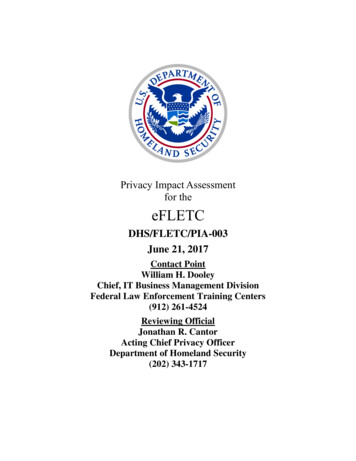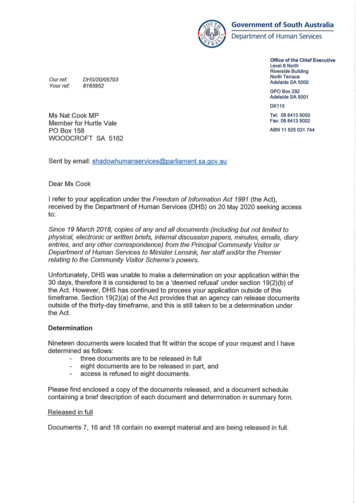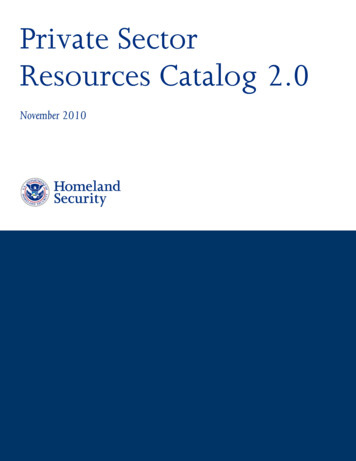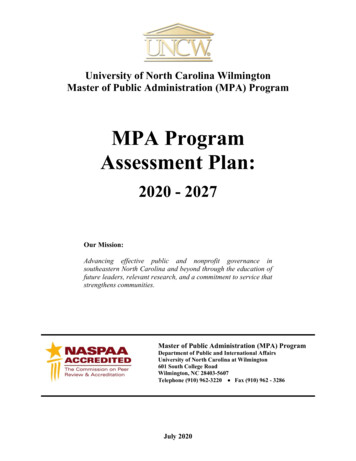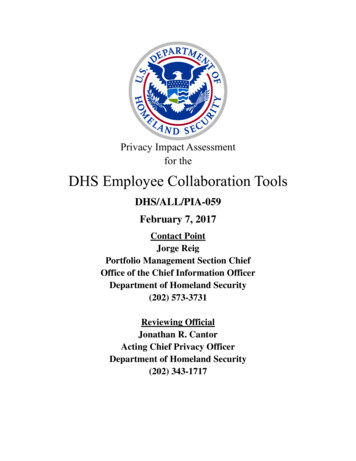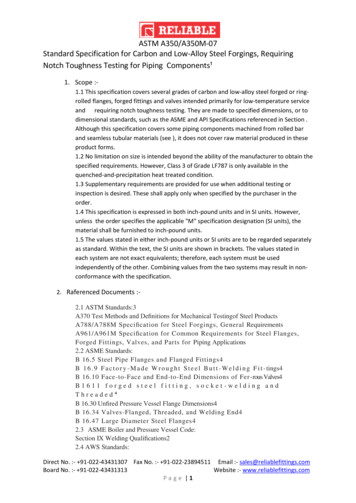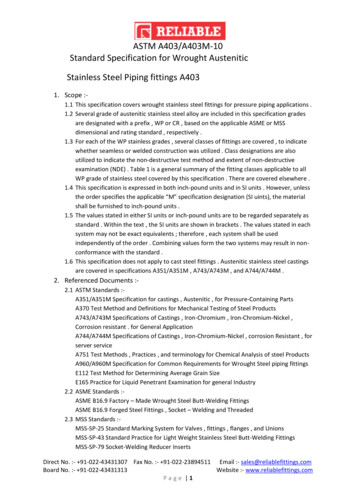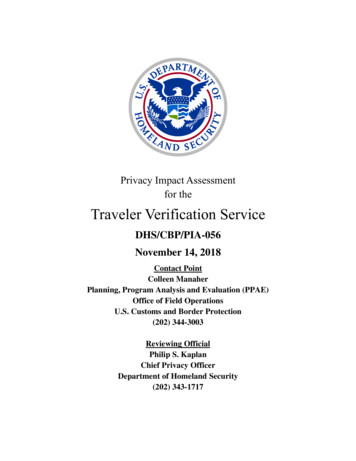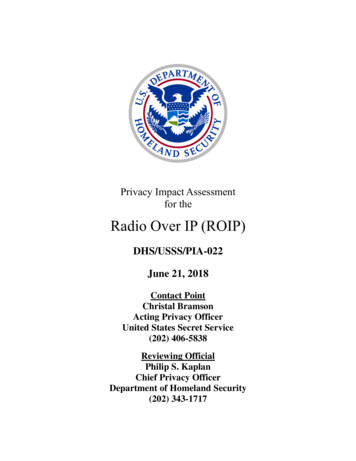
Transcription
Privacy Impact Assessmentfor theRadio Over IP (ROIP)DHS/USSS/PIA-022June 21, 2018Contact PointChristal BramsonActing Privacy OfficerUnited States Secret Service(202) 406-5838Reviewing OfficialPhilip S. KaplanChief Privacy OfficerDepartment of Homeland Security(202) 343-1717
Privacy Impact AssessmentDHS/USSS/PIA-022 Radio Over IP (ROIP)Page 1AbstractThe Department of Homeland Security (DHS) United States Secret Service (USSS) Radioover IP (RoIP) system is a Land Mobile Radio (LMR) system, or a secure wireless radiocommunications system, deployed to provide voice and voice management needs for protectiveand investigative personnel. USSS RoIP is used by USSS protective details to ensure the securityof protectees and protected locations through encrypted communications to and from USSSheadquarters. Additionally, USSS uses RoIP for communication during criminal investigations infurtherance of USSS’s investigative mission. The USSS is conducting this privacy impactassessment (PIA) because the RoIP system may collect and store personally identifiableinformation (PII) during the normal course of operations.OverviewUSSS requires a communications system that provides mission critical tacticalcommunications, operational planning, radio network control services, and investigative andprotective information communications to support USSS operations and other law enforcementactivities. The USSS RoIP system is an internal, encrypted LMR communications systemresponsible for critical voice and data needs for USSS personnel. The RoIP system transmits andreceives (TX/RX) encrypted voice communications to and from USSS Headquarters (HQ). TheRoIP system records all audio transmissions through a digital audio logging recorder located atUSSS headquarters. The RoIP system may capture PII such as name or physical description invoice communications and subsequently maintain the PII by the digital audio logging recorder forno more than 30 days at USSS HQ. Not all data collected by the RoIP system may be used toidentify an individual at the time of collection; however, data captured using the RoIP may laterbe associated with an individual. USSS is better able to respond to and coordinate its protectiveand investigative responses to events using RoIP technology, or a secure wireless radiocommunications system, as described in this PIA. Below are descriptions of the different uses forthe RoIP system by the USSS:Uses The RoIP system provides USSS with radio communications supporting security at theWhite House Complex, the Vice President’s residence, the Department of the Treasury(as part of the White House Complex), and foreign diplomatic missions. U.S. Treasurypersonnel do not have access to the RoIP system. Protective details of the agency use RoIP to ensure the security of the President and VicePresident and their families, national and visiting world leaders, former Presidents, andevents of national significance in the Washington, D.C. area.
Privacy Impact AssessmentDHS/USSS/PIA-022 Radio Over IP (ROIP)Page 2 RoIP is used for interoperability between the White House Communications Agency(WHCA) and many other federal, state, and local agencies. There is sharedcommunications between the USSS and WHCA LMR systems. The dispatch units for therespective organizations receive the transmissions. However, the recordings are logicallyseparated, and each agency does not have access to another agency’s recordings. RoIP may also be used to provide communications while a particular individual orlocation is being surveilled as part of a law enforcement investigation. The recordedcommunications may be used as evidence if they became associated with an ongoing lawenforcement investigation and official case file. The recorded communications areretrieved by date, location, hours, or channel (frequency band used) during a criminalproceeding and not by personal identifiers.All USSS personnel with access to the RoIP system are cleared and approved by the USSSSecurity Management Division (SMD). SMD personnel do not have access to RoIP but processthe USSS clearances for personnel who have been granted access. Only personnel assigned to theRadio Branch have the capability to access RoIP audio recordings.RoIP communications are managed by the Wide Area Virtual Environment (WAVE)system from USSS HQ-managed desktops. WAVE is a commercial software not available to thepublic. WAVE is accessed through a web-portal interface administered by and restricted toauthorized RoIP personnel from computers on the USSS network. Authorized users log on to theircomputers and are authenticated through the use of two-factor authentication (PIV cards).Authorized users then open a WAVE console on their computer to manage radio communications.RoIP records radio conversations between USSS personnel in the field and dispatchoperators. The USSS uses audio logs to retrace the activity when investigating incidents involvingUSSS personnel. The recordings are filed and tagged by date and time. The audio files are kept fora period of no longer than 30 days on a USSS recording device, JEI Digital Voice Recorder DVLFS Series, hosted at USSS HQ. After 30 days, recordings are overwritten by the system unless theinformation is used in support of ongoing law enforcement investigations through a USSS CourtLiaison request by the appropriate federal law enforcement agency or prosecutor. In the event thatan audio file is requested to support an ongoing law enforcement investigation, the audio file istransferred to a secondary server where it is housed until the close of the investigation.Federal and local authorities can also make requests to obtain recordings via a Freedom ofInformation Act (FOIA) request. Once a request is received, the USSS Uniformed Division willrequest the recording from the USSS Radio Branch and provide the associated investigative casefile number. Once the file is located, it is placed on a DVD and logged via an Audio RecordsReceipt. The USSS Radio Branch maintains a binder containing a log of all audio file requests. Acopy of the initial request and associated Audio Records Receipt is also retained.
Privacy Impact AssessmentDHS/USSS/PIA-022 Radio Over IP (ROIP)Page 3All USSS hardware assets are assigned a Secret Service Property Number (SSPN). Thephysical radios utilized in support of the RoIP system are considered USSS hardware and haveSSPN numbers for tracking within the Sunflower Asset Management application. All assetsassigned to an individual, including radios, are tracked via Sunflower. The Sunflower applicationis part of the USSS Travel Manager, Oracle Financials, PRISM, Sunflower (TOPS) system.1 NoRoIP data is input or processed within Sunflower.Section 1.0 Authorities and Other Requirements1.1What specific legal authorities and/or agreements permit anddefine the collection of information by the project in question?USSS investigative and protective functions are authorized by 18 U.S.C. §§ 3056 and3056A, as well as 18 U.S.C. §§ 871, 879, 1029, 1030, and 1752.1.2What Privacy Act System of Records Notice(s) (SORN(s)) applyto the information?Audio recordings made in RoIP are not retrieved using personal identifiers and, therefore,do not constitute a system of records under the Privacy Act of 1974. Recordings from the RoIPsystem are deleted after 30 days unless the recording is relevant to an active case file for a lawenforcement investigation or prosecution. USSS does not associate the recordings with anindividual unless the individual is later apprehended or otherwise identified as part of lawenforcement investigation. In those instances the recorded communications may be used asevidence if they became associated with an ongoing law enforcement investigation and officialcase file, and are covered under the Secret Service’s Criminal Investigation Information SORN2or the Protection Information System SORN.31.3Has a system security plan been completed for the informationsystem(s) supporting the project?Yes. RoIP is in the process of completing its Authority to Operate (ATO) certification,which includes a System Security Plan. An ATO is expected to be granted pending approval ofthis PIA.1For more information, see DHS/ALL/PIA-053 DHS Financial Management Systems, available 001 Criminal Investigation Information, 76 FR 49497 (August 10, 2011).3DHS/USSS-004 Protection Information System, 76 FR 66940 (October 28, 2011).
Privacy Impact AssessmentDHS/USSS/PIA-022 Radio Over IP (ROIP)Page 41.4Does a records retention schedule approved by the NationalArchives and Records Administration (NARA) exist?Yes. The USSS RoIP system is covered by NARA-approved retention schedule numberN1-087-06-001. The RoIP temporarily retains audio recordings for 30 days and then automaticallydeletes them on the 31st day unless requested for authorized law enforcement investigations orprosecutions as part of a particular case, significant event, pending or current litigation, or specialrequests. To the extent the recordings are associated with a case file, the information becomes apart of that file and will be retained for the time period specified in the applicable records retentionschedule.1.5If the information is covered by the Paperwork Reduction Act(PRA), provide the OMB Control number and the agency numberfor the collection. If there are multiple forms, include a list in anappendix.Due to the law enforcement nature of this information collection, the information that RoIPcollects is not covered by the Paperwork Reduction Act. No information is collected in astandardized format directly from members of the public.Section 2.0 Characterization of the Information2.1Identify the information the project collects, uses, disseminates, ormaintains.The RoIP system is used for radio communications by the Secret Service’s protectivedetails and the Washington Field Office as part of the USSS’s protective and investigative mission.In the course of performing these protective and investigative functions, the communications madeon the RoIP system may include PII/sensitive PII (SPII), such as when conveying the physicaldescription of a person or attempting to confirm the identity of an individual. Examples of PII/SPIIthat may be captured in these radio communications include: names, physical descriptions,addresses, drivers’ license numbers, license plate numbers, and Social Security numbers (SSN)depending on the situation encountered by USSS personnel.2.2What are the sources of the information and how is theinformation collected for the project?The RoIP system logs all audio transmissions between USSS special agents, officers, anddispatch operators through a digital voice recorder hosted at USSS HQ. Recordings may containPII/SPII (e.g., name, physical description, SSN), but are not identified or retrieved by PII/SPII.Recordings are identified and retrieved by date, location, hours, and channel.
Privacy Impact AssessmentDHS/USSS/PIA-022 Radio Over IP (ROIP)Page 52.3Does the project use information from commercial sources orpublicly available data? If so, explain why and how thisinformation is used.No. The RoIP system does not use information from public or commercial sources.2.4Discuss how accuracy of the data is ensured.Audio logs are kept for a period of 30 days and then deleted by the system unless theinformation is requested as part of a particular case, significant event, pending or current litigation,or special request. When requested, trained USSS personnel retrieve the pertinent recordedtransmission. The recordings are identified and retrieved by date, location, hours, and channel andsaved to a write-once, read-many (WORM) DVD. The integrity of audio recordings is ensuredthrough established chain of custody procedures and physical security. The recording device is ina locked room accessible only by authorized individuals via badge access within USSS HQ.Recordings can only be accessed by radio personnel with administrative rights.If the data is associated with an open investigation, the accuracy of any PII contained inthat recording is verified as part of the investigation.2.5Privacy Impact Analysis: Related to Characterization of theInformationPrivacy Risk: There is a risk that RoIP may capture information about individuals whoare not relevant to USSS protective and investigative functions.Mitigation: The RoIP system records voice communications that occur near USSSprotectees, at protected locations, and during authorized investigations and would involvecommunications for which there is probable cause to obtain information about an individual. Allinformation collected that is not needed to carry out the Agency’s mission is discarded after 30days. The USSS retains recordings from the RoIP system only when they are relevant to aparticular case, significant event, pending or current litigation, or special requests. Additionally,USSS does not associate the recordings with an individual unless the individual is laterapprehended or otherwise identified as part of a law enforcement investigation. In those instancesthe recordings would become part of an official case file, and are covered under the SecretService’s Criminal Investigation Information and System of Records,4 or the ProtectionInformation System of Records.545DHS/USSS-001 Criminal Investigation Information, 76 FR 49497 (August 10, 2011).DHS/USSS-004 Protection Information System, 76 FR 66940 (October 28, 2011).
Privacy Impact AssessmentDHS/USSS/PIA-022 Radio Over IP (ROIP)Page 6Privacy Risk: There is a risk of over collection of information thought to be relevant to aninvestigation.Mitigation: This risk is partially mitigated. Secret Service provides training to personnelin collecting and retaining only information that is necessary to validate identification and carryout the Agency’s mission. If information is later determined to not be germane to an openinvestigation, the associated audio file is deleted after 30 days.Section 3.0 Uses of the Information3.1Describe how and why the project uses the information.The RoIP system, as an LMR, is used to enable USSS personnel to conduct protective andinvestigative functions while mobile. The system is used for communication purposes to requestinformation about a subject, such as names, physical descriptions, addresses, driver’s licensenumbers, SSNs, and other information depending on the circumstance. During an encounter witha subject, USSS personnel will use the radio to contact dispatch to request additional informationon the individual. The information obtained is used to identify an individual or to describe a personin the course of agency protective, investigative, and law enforcement functions.3.2Does the project use technology to conduct electronic searches,queries, or analyses in an electronic database to discover or locatea predictive pattern or an anomaly? If so, state how DHS plans touse such results.No.3.3Are there other components with assigned roles andresponsibilities within the system?No.3.4Privacy Impact Analysis: Related to the Uses of InformationPrivacy Risk: There is a potential risk of unauthorized access, use, or disclosure of audiorecordings from RoIP.Mitigation: Access to RoIP recordings is limited to those specific USSS employees(personnel of the Radio Branch) that must use the system as part of their assigned duties.Equipment use is tracked and monitored for accountability. Authorized users and systemadministrators are the only individuals with access to the system and recordings. All equipmentand archives are stored in secure facilities with restricted access. USSS does not share theinformation with any other component or agency unless it is associated with a particular case,
Privacy Impact AssessmentDHS/USSS/PIA-022 Radio Over IP (ROIP)Page 7significant event, pending or current litigation, or special request. When linked to a USSS case,the recordings become part of an official case file, and are covered under the Secret Service’sCriminal Investigation Information SORN,6 or the Protection Information System SORN.7Information sharing complies with the routine uses of the respective SORNs.Section 4.0 Notice4.1How does the project provide individuals notice prior to thecollection of information? If notice is not provided, explain whynot.In addition to this PIA, the DHS/USSS-004 Protection Information Systems andDHS/USSS-001 Criminal Investigation System SORNs provide general notice regarding thecollection of information and how USSS may share the information collected. Additionally, if theinformation is obtained by the agent or officer directly from an individual, that individual will beaware that the agent or officer is collecting that information. Advanced notice of the collection ofinformation to investigative targets or others involved in an investigation generally is not providedas it would compromise ongoing law enforcement investigations and otherwise impede lawenforcement proceedings.4.2What opportunities are available for individuals to consent touses, decline to provide information, or opt out of the project?USSS does not provide opportunities for individuals to consent to, decline, or opt out ofthe project because doing so could compromise ongoing law enforcement investigations andotherwise impede law enforcement proceedings. However, if a witness or subject is asked forinformation, they may decline to interact with USSS or answer questions.4.3Privacy Impact Analysis: Related to NoticePrivacy Risk: The recorded radio communications may include information about anindividual(s) later determined to be unrelated the Agency’s mission and who were unaware theirinformation was being recorded.Mitigation: This risk is partially mitigated. An individual that provides informationdirectly to an agent or officer will be aware that the information is being collected. Due to thenature of the law enforcement activity being performed, not all individuals can be given notice ofdata collection. Furthermore, individuals may not be aware of conversations recorded using thissystem that may involve their information; in such cases, USSS cannot provide timely notice. This67DHS/USSS-001 Criminal Investigation Information, 76 FR 49497 (August 10, 2011).DHS/USSS-004 Protection Information System, 76 FR 66940 (October 28, 2011).
Privacy Impact AssessmentDHS/USSS/PIA-022 Radio Over IP (ROIP)Page 8PIA serves as public notice of the existence of the RoIP system in support of the Secret Service’smissions and that communications over the RoIP system are recorded. Recordings that do notbecome associated with investigative case files or other actions are automatically deleted after 30days.Section 5.0 Data Retention by the project5.1Explain how long and for what reason the information is retained.The RoIP temporarily retains audio recordings for 30 days and then automatically deletesthem on the 31st day unless requested for authorized law enforcement investigations orprosecutions as part of a particular case, significant event, pending or current litigation, or specialrequests. To the extent the recordings are associated with a case file, the information becomes apart of that file and will be retained for the time period specified in the applicable records retentionschedule; USSS Records Control Schedule NC1-087-84-01 states information that is collected thatbecomes part of an investigative case file will be retained as a component part of that file for aperiod which corresponds to the specific case type developed. DHS is currently developing anEnterprise Records Disposition Schedule that will standardize retention across all components forthis type of information; and when approved, USSS will adopt and adhere to the retentionprovisions of that new Enterprise Schedule.5.2Privacy Impact Analysis: Related to RetentionPrivacy Risk: There is the risk that audio recordings may be retained by RoIP for a longerperiod than is required for the purpose for which the audio file was collected.Mitigation: All data recorded by the RoIP system that does not warrant further Agencyactions is overwritten automatically after 30 days per NARA retention schedule N1-087-06-001.Audio files that are associated with a case file become a part of that case file and are retained fora prescribed period of time in accordance with the appropriate established records retentionschedule. Audio files are not identified by and cannot be retrieved with a personal identifier, unlessthey become part of a case file.Section 6.0 Information Sharing6.1Is information shared outside of DHS as part of the normalagency operations? If so, identify the organization(s) and how theinformation is accessed and how it is to be used.No. Normal RoIP operations do not provide for sharing of voice recordings with outsideagencies. Upon request of an appropriate law enforcement agency or prosecutor’s office, the USSS
Privacy Impact AssessmentDHS/USSS/PIA-022 Radio Over IP (ROIP)Page 9will make a copy of a recording associated with a particular case, significant event, pending orcurrent litigation, or special requests in furtherance of an investigation or prosecution if therecording is still available. After 30 days, the recording is deleted and cannot be retrieved.Recordings that become part of an investigative case file may be shared on a need-to-know basiswith federal, state, and local law enforcement agencies, other foreign and domestic governmentunits, or private entities in accordance with the routine uses outlined in the applicable SORNs. TheRoIP system does not create files or any documents that link to recorded audio. Recordings are notidentified or retrieved through use of PII/SPII.6.2Describe how the external sharing noted in 6.1 is compatible withthe SORN noted in 1.2.RoIP does not maintain data that is retrieved through use of PII/SPII, and therefore RoIPis not subject to a SORN. For recordings that are associated with an open case file, routine uses inthe DHS/USSS-004 Protection Information Systems and DHS/USSS-001 Criminal InvestigationSystem SORNs specifically authorize the disclosure of information on a need-to-know basis tofederal, state, and local law enforcement agencies, other foreign and domestic government units,or private entities in certain situations relevant to the USSS mission. The information within RoIPis collected and shared only for law enforcement purposes.6.3Does the project place limitations on re-dissemination?Yes. USSS shares audio from the RoIP system only when requested as part of a particularcase, significant event, pending or current litigation, or special request. Dissemination toauthorized recipients is necessary to further criminal investigations or to support protectiveoperations.6.4Describe how the project maintains a record of any disclosuresoutside of the Department.Audio files that are shared outside of the USSS are tracked through a log book of allrequests received. In addition, an audio recording file receipt is completed by the recipient of theaudio file. The form includes the date, nature, purpose of each disclosure, and the name and addressof the individual agency to which disclosure is made. Requests for disclosure must be approvedby the Program Director and are documented locally.6.5Privacy Impact Analysis: Related to Information SharingPrivacy Risk: There is a risk that audio containing PII/SPII may be disclosed to anunauthorized recipient.Mitigation: This risk is partially mitigated. When making the call to dispatch, it is possiblethat bystanders could overhear the information being relayed. Outside of this instance, USSS limits
Privacy Impact AssessmentDHS/USSS/PIA-022 Radio Over IP (ROIP)Page 10disclosure of information to only law enforcement agencies and prosecutors’ offices whenrequested. USSS does not use recordings to identify an individual, but instead to complete lawenforcement investigative and protective duties. In those instances, the Radio Branch personnelmay only share this information pursuant to the routine uses specified in the Secret Service’sCriminal Investigation Information SORN,8 or the Protection Information SORN.9Section 7.0 Redress7.1What are the procedures that allow individuals to access theirinformation?Conversations recorded by the RoIP system are not generally subject to the provisions ofthe Privacy Act of 1974 because the recordings are not retrieved by personal identifier. To theextent the recordings become part of the Agency’s case files, the procedures for access are statedin the SORNs for the applicable systems of records: DHS/USSS-001 Criminal InvestigationInformation and DHS/USSS-004 Protective Information. USSS investigative and protectiverecords are exempted from the Privacy Act’s notification, access, and amendment provisions.However, in those instances in which records become part of an investigative case file, U.S.citizens and Lawful Permanent Residents seeking access to any information contained in RoIP, orseeking to contest its content, may submit a request in writing to the USSS Freedom of InformationAct/Privacy Act (FOIA/PA) Officer, Communications Center (FOIA/PA), 245 Murray Lane,Building T-5, Washington, D.C. 20223, as specified in the applicable SORN. Individuals,regardless of citizenship or legal status, may request access to their records under FOIA.Notwithstanding the applicable exemptions, USSS reviews all such requests on a case-by-casebasis. If compliance with a request would not interfere with, or adversely affect theaccomplishment of the Secret Service’s protective and investigatory mission, information may bereleased or amended.7.2What procedures are in place to allow the subject individual tocorrect inaccurate or erroneous information?Conversations recorded by the RoIP system are not subject to the amendment provisionsof the Privacy Act of 1974, as they are not retrieved through the use of a personal identifier, and,may be exempt from the Privacy Act’s access and amendment provisions. In instances in whichrecords become part of an investigative case file, correction of information is outlined in theSORNs associated with those files. The applicable SORN notifies individuals how to correct theirinformation. USSS will review each request and grant amendment on a case-by-case basis.89DHS/USSS-001 Criminal Investigation Information, 76 FR 49497 (August 10, 2011).DHS/USSS-004 Protection Information System, 76 FR 66940 (October 28, 2011).
Privacy Impact AssessmentDHS/USSS/PIA-022 Radio Over IP (ROIP)Page 117.3How does the project notify individuals about the procedures forcorrecting their information?Conversations recorded by the RoIP system are not subject to the notification provisionsof the Privacy Act of 1974 as they are not retrieved through the use of personal identifiers. Noticethat records in this system may be exempted from the access and amendment procedures of thePrivacy Act is outlined in this PIA in Sections 7.1 and 7.2. In instances in which records becomepart of an investigative case file, correction of information is outlined in the SORNs associatedwith those files.7.4Privacy Impact Analysis: Related to RedressPrivacy Risk: There is the risk individuals may have their information erroneouslyassociated with a crime without the ability to correct it.Mitigation: USSS does not use recordings to identify an individual, but instead tocomplete law enforcement investigative and protective duties. An individual may contest theassociation with a particular recording during the course of the subsequent criminal proceeding ifhe or she is erroneously associated with the recording. As stated above, in those instances in whichrecords become part of an investigative case file, correction of information is outlined in theSORNs associated with those files.Section 8.0 Auditing and Accountability8.1How does the project ensure that the information is used inaccordance with stated practices in this PIA?Only authorized users have access to the files recorded in the system. The files can beidentified only by date, location, hours, and channel on which the recording took place. RoIPprovides a copy of pertinent audio files only when requested internally or by an appropriate lawenforcement agency or prosecutor’s office to support an investigation or open case. Any requestsare routed through the USSS Office of Chief Counsel and USSS Privacy Office for review. Anyshared recording is logged with the same date, location, hours, and channel data before beingreleased to an authorized individual for transport to the requesting authority.8.2Describe what privacy training is provided to users eithergenerally or specifically relevant to the project.All USSS personnel undergo initial security awareness training and complete the DHSsecurity awareness and rules of behavior training course and a privacy awareness course on an
Privacy Impact AssessmentDHS/USSS/PIA-022 Radio Over IP (ROIP)Page 12annual basis. In addition, system specific paper-based (booklet form) training is provided byvendors for specific equipment and applications, and is shared by all users.8.3What procedures are in place to determine which users mayaccess the information and how does the project determine whohas access?Only personnel cleared by the USSS Security Management Division (SMD) and assignedto the Radio Branch have the capability to access audio recordings.8.4How does the project review and approve information sharingagreements, MOUs, new uses of the information, new access to thesystem by organizations within DHS and outside?The RoIP system does not have existing or planned Memoranda of Understanding orinformation sharing agreements. Audio segments are only provided to law enforcement agenciesor prosecutor’s offices as part of legal investigations or prosecutions upon request. Access to thesystem is not available to anyone not identified in Section 8.3.Respons
DHS/USSS/PIA-022 Radio Over IP (ROIP) Page 2 RoIP is used for interoperability between the White House Communications Agency (WHCA) and many other federal, state, and local agencies. There is shared communications between the USSS and WHCA LMR systems. The dispatch units for the respective organizations receive the transmissions.
